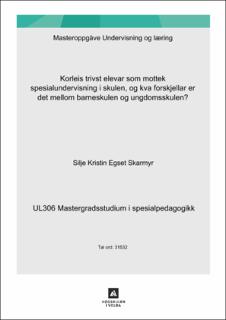Korleis trivst elevar som mottek spesialundervisning i skulen, og kva forskjellar er det mellom barneskulen og ungdomsskulen?
Abstract
Summary
This thesis investigates the well-being of students with special education, and if there are any differences between students in elementary school and lower secondary school. The method that is used is a quantitative method. In the research it has been used data from the SPEEDproject. The SPEED-project is a collaboration between Volda University College and Hedmark University College. The aim of the project was to investigate what special education is about and what its function is. In the project it was used surveys that was answered by students and teachers. Data from these surveys are used in the analyses in this thesis. SPSS, which is a program for statistical analysis, has been used to analyse the data.
Well-being is a term that is difficult to measure, because it isn´t something visible. We have to find different indicators that affects the well-being and that are measurable. In addition to investigate the well-being of students, indicators of well-being have been investigated. These are the relationship to the teacher, the relationship between pupils and motivation.
The results show that in two areas, well-being and motivation, there is a difference between students with special education and students in the ordinary education. Children who receives special education have a lower well-being and motivation than children in ordinary education. Especially in motivation the results showed a big difference between children with and without special education. In the two other areas, relationship to the teacher and relationship between students, there was a small difference between students with special education and students in ordinary education. Both groups had quite good relationship to their teacher and fellow students.
The results also show that there is a difference between the well-being of students in elementary school and lower secondary school. Both students with and without special education had a higher well-being in elementary school than in lower secondary school. Something interesting is that in all the four areas that has been investigated it is in the 9th grade the students had the lowest score. Sammendrag
I denne masteroppgåva er det undersøkt korleis elevar som mottek spesialundervisning trivst i skulen, og om det er forskjellar mellom elevar i barneskulen og ungdomsskulen. Metoden som er brukt er kvantitativ metode. Undersøkinga har nytta seg av data frå SPEED-prosjektet. SPEED-prosjektet er eit samarbeid mellom høgskulen i Volda og Høgskolen i Innland avdeling Hamar. Føremålet med prosjektet var å undersøkje kva spesialundervisning handlar om og kva funksjon den har. I prosjektet blei det gjennomført surveyundersøkingar som elevar og lærarar svara på. Data frå desse undersøkingane er brukt i analysane i denne oppgåva. For å analysere data er det brukt SPSS, som er eit program for statistisk berekning.
Trivsel er eit omgrep som er vanskeleg å måle, sidan det ikkje er noko synbart. Ein må difor finne andre indikatorar som påverkar trivselen og er målbare. I tillegg til å undersøkje trivselen til elevane har oppgåva også sett på pådrivarar til trivsel. Desse er relasjon til lærar, relasjon til medelevar og motivasjon.
Resultata viser at innan to område, trivsel og motivasjon, er det skilnadar mellom elevane med og utan spesialundervisning. Elevar med spesialundervisning har lågare trivsel og motivasjon enn elevar i den ordinære undervisninga. Særleg innan motivasjon viste resultata at det er ein stor skilnad mellom elevane med og utan spesialundervisning. Innan dei to andre områda, relasjon til lærar og relasjon til medelevar, var det liten forskjell mellom elevane med og utan spesialundervisning. Begge elevgruppene har nokså god relasjon til både læraren og medelevar.
Resultata viser og at det er forskjell mellom trivselen til elevane i barneskulen og ungdomsskulen. For både elevar med og utan spesialundervisning hadde dei betre trivsel på barneskulen enn på ungdomsskulen. Noko interessant er at innan alle dei fire områda som er undersøkt, var det på 9.trinn det var lågast skåre
